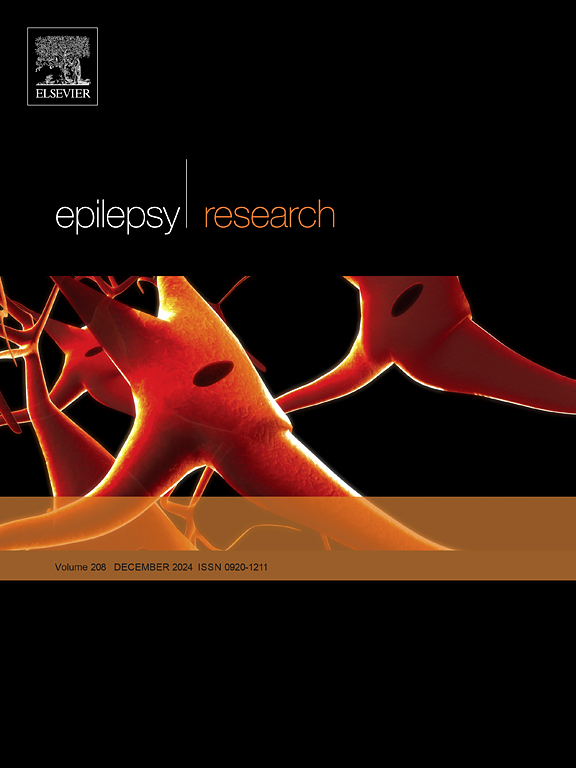Clinical efficacy of lacosamide monotherapy in children with focal epilepsy and comorbid depression and its impact on peripheral blood interleukin-6 and serotonin expression
IF 2
4区 医学
Q3 CLINICAL NEUROLOGY
引用次数: 0
Abstract
Objective
To evaluate the clinical efficacy of lacosamide monotherapy in adolescents with focal epilepsy and comorbid depression and its effects on peripheral blood interleukin-6 (IL-6) and serotonin (5-HT) levels.
Methods
A total of 116 adolescents (12–18 years) newly diagnosed with focal epilepsy and depression between June 2022 and December 2023 were randomly assigned to the lacosamide group (n = 53) and the oxcarbazepine group (n = 63). The treatment duration ranged from 6 to 12 months. Outcomes included epilepsy control rates, the Hamilton Depression Scale (HAMD) scores, peripheral IL-6 and 5-HT levels and adverse drug reactions.
Results
After 6 months, epilepsy control in the lacosamide group reached 64.71 %, comparable to the oxcarbazepine group (P < 0.05). At 12 months, the lacosamide group achieved a higher control rate than the oxcarbazepine group (89.13 % vs 73.02 %, P < 0.05). Both groups showed no baseline differences in the HAMD scores, IL-6 and 5-HT levels. In the lacosamide group, the HAMD scores and IL-6 levels decreased, whereas 5-HT levels increased significantly at 6 and 12 months compared with baseline (P < 0.05). The incidence of adverse reactions in the lacosamide group was 15.09 %, which was lower than that in the oxcarbazepine group (P < 0.05).
Conclusion
Lacosamide monotherapy effectively controls seizures and alleviates depressive symptoms in adolescents with focal epilepsy and depression. These benefits may be associated with decreased IL-6 and increased 5-HT levels. Lacosamide also demonstrated a favourable safety profile.
拉科沙胺单药治疗局灶性癫痫合并抑郁患儿的临床疗效及对外周血白细胞介素-6和血清素表达的影响
目的评价拉科沙胺单药治疗青少年局灶性癫痫合并抑郁症的临床疗效及对外周血白细胞介素-6 (IL-6)、血清素(5-HT)水平的影响。方法将2022年6月~ 2023年12月新诊断为局灶性癫痫和抑郁症的青少年116例(12-18岁)随机分为拉科沙胺组(n = 53)和奥卡西平组(n = 63)。治疗时间为6 ~ 12个月。结果包括癫痫控制率、汉密尔顿抑郁量表(HAMD)评分、外周IL-6和5-HT水平以及药物不良反应。结果6个月后,拉科沙胺组癫痫控制率达到64.71 %,与奥卡西平组相当(P <; 0.05)。12个月时,拉科沙胺组控制率高于奥卡西平组(89.13 % vs 73.02 %,P <; 0.05)。两组在HAMD评分、IL-6和5-HT水平上均无基线差异。在拉科沙胺组,HAMD评分和IL-6水平下降,而5-HT水平在6个月和12个月时与基线相比显著升高(P <; 0.05)。拉科沙胺组不良反应发生率为15.09 %,低于奥卡西平组(P <; 0.05)。结论拉科沙胺单药治疗可有效控制青少年局灶性癫痫和抑郁症患者的癫痫发作,减轻抑郁症状。这些益处可能与降低IL-6和增加5-羟色胺水平有关。拉科沙胺也显示出良好的安全性。
本文章由计算机程序翻译,如有差异,请以英文原文为准。
求助全文
约1分钟内获得全文
求助全文
来源期刊

Epilepsy Research
医学-临床神经学
CiteScore
0.10
自引率
4.50%
发文量
143
审稿时长
62 days
期刊介绍:
Epilepsy Research provides for publication of high quality articles in both basic and clinical epilepsy research, with a special emphasis on translational research that ultimately relates to epilepsy as a human condition. The journal is intended to provide a forum for reporting the best and most rigorous epilepsy research from all disciplines ranging from biophysics and molecular biology to epidemiological and psychosocial research. As such the journal will publish original papers relevant to epilepsy from any scientific discipline and also studies of a multidisciplinary nature. Clinical and experimental research papers adopting fresh conceptual approaches to the study of epilepsy and its treatment are encouraged. The overriding criteria for publication are novelty, significant clinical or experimental relevance, and interest to a multidisciplinary audience in the broad arena of epilepsy. Review articles focused on any topic of epilepsy research will also be considered, but only if they present an exceptionally clear synthesis of current knowledge and future directions of a research area, based on a critical assessment of the available data or on hypotheses that are likely to stimulate more critical thinking and further advances in an area of epilepsy research.
 求助内容:
求助内容: 应助结果提醒方式:
应助结果提醒方式:


